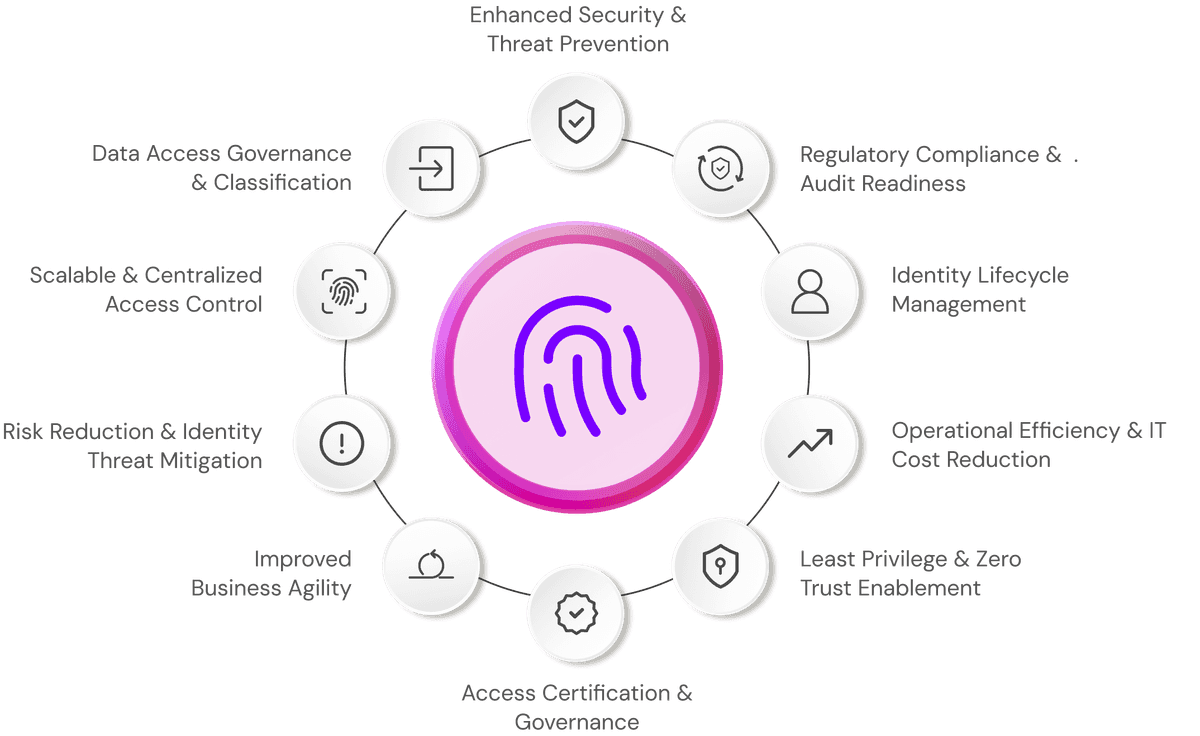
Top 10 Benefits of Identity Governance and Administration (IGA)

Identity Governance and Administration (IGA) is the practice through which organisations control who has access to what, when, and why, while maintaining that access as safe, policy-based, and audit-ready. With ever-more intricate industry systems, IGA has evolved into a foundational element of security, compliance, and operational effectiveness. It allows expanding businesses to automate access controls, impose least privilege, and maintain clear visibility across hybrid environments, all while meeting standards such as GDPR, HIPAA, and SOX.
Business email hack attempts, as reported by the FBI, cost companies an average of over $137,000. Proper identity administration is the most efficient way to avert unauthorized access.
Key Takeaways:
- Automates provisioning and lifecycle tasks, reducing errors and IT workload
- Helps meet compliance mandates with built-in audit trails and reviews
- Enhances visibility and access control across all systems
- Supports Zero Trust and least privilege enforcement
- Enables scalable, centralized, and real-time identity management
Let’s walk through the top benefits that can strengthen security, simplify access control, and keep your business businesses compliant and ready.
1. Enhanced Security and Threat Prevention
Identity governance and administration have several benefits, but one of the most important is that they strengthen security by enforcing least privilege access, which is also known as the Principle of Least Privilege (PoLP). This method ensures that each user only has the minimum access they need to do their job, which lowers the risk of misuse, whether on purpose or by accident.
As business systems get more complicated, the hazards of too many permissions, inactive accounts, and insufficient access controls also rise. Identity governance technologies help to limit these risks by giving centralised visibility into user entitlements, allowing you to easily understand who has access to what and what actions they may take across apps and databases. This insight enables organisations to spot access mismatches, violations of internal policies, and overprovisioned accounts before they become security risks.
Aside from static access assessments, current IGA solutions leverage behavioural analytics to detect anomalous activity, such as login attempts from unexpected locations or users attempting to access data outside of their responsibilities
2. Regulatory Compliance & Audit Readiness
Identity Governance and Administration (IGA) is an essential component of helping companies meet a wide range of compliance mandates like GDPR, HIPAA, SOX, and regulations like the NIST Cybersecurity Framework. With more and more data privacy laws and more frequent audits, business organisations need a way to prove control always, all the time, and as required.
IGA simplifies reporting compliance by automation and streamlining important actions like access reviews, policy enforcement, and user certifications. Instead of relying on standalone spreadsheets or following manual methods, enterprises can rely on scheduled, policy-based reviews to make sure each user's access is correct, current, and documented. The process eliminates the likelihood of errors or omissions that can result in audit findings.
Real-time dashboards and access logs give internal teams and auditors complete visibility into system access and user entitlements from end-to-end. All access changes are logged, reviewed, and certified, making compliance proactive instead of reactive. By integrating compliance into normal identity tasks, IGA provides a transparent and consistent method of audit preparation, whether in least privilege, compliance or in policy breach remediation.
3. Identity Lifecycle Management
Effective identity governance begins with lifecycle management automation. That is the granting, modification, and removal of user access as roles shift or when user joins or leaves the company. Adding a new employee, transferring a person to a different job, or handling someone's departure, this process is called provisioning and deprovisioning, IGA synchronizes access with business requirements and in real-time.
Provisioning is to provide users the correct access and permissions in an automated manner when they begin working within a business or switch jobs. By employing rules-based role-based access control (RBAC) or modifying information such as department, job title, or location, IGA tools integrate with identity providers (such as Okta and Azure AD) and business applications through mechanisms such as SCIM or custom connectors. This allows administrators to automate the creation of user accounts and set permissions between multiple systems without having to do so manually.
Deprovisioning revokes access immediately when a user departs an organization or no longer requires specific privileges. This is highly security-critical activity as inactive accounts can be misused if not properly managed. By connecting with HR software or services, the IGA platform catches a switch in roles and revokes access from all concerned systems.
This automated process, according to policies in place, reduces the danger of delayed access, errors, and over-granting of access while maintaining each identity in synchronization with what the business requires. This equates to improved access management and seamless integration between people, processes, and technology.
4. Operational Efficiency & IT Cost Reduction
Identity Governance and Administration (IGA) streamlines work by automating the repetitive IT tasks, especially user access and certification. Manually, they take time, cause errors, and generate a large number of support tickets. It can take days or weeks to provide access. This annoys users and puts pressure on the IT teams and adversely affects overall service level agreements (SLA).
IGA platforms solve such problems through the use of rules to automate tasks. Access is automatically granted, changed, or revoked when an employee is hired, changes jobs, or leaves the company, based on rules defined for their role. Approvals and checks are automatic, and thus there is no place for spreadsheets and less work for humans. By automating business processes and standardizing procedures, companies can achieve administrative overhead costs savings of 30–50%. Onboarding and deprovisioning is expedited, enabling employees to get up and running very quickly, and security threats from stale accounts are eliminated.
5. Least Privilege and Zero Trust Enablement
The unifying concept of contemporary cybersecurity strategies is the Zero Trust model: "never trust, always verify." Identity Governance and Administration (IGA) is central to implementing this model by ensuring least privilege access, i.e., providing users and systems with only the privileges they require and no excess.
IGA systems are rules-based for access control which can vary depending on factors such as the user's role, device type, location, or the risk level. For example, a marketing employee should not be able to access sensitive HR systems at any given time and if they attempt to log in at an unusual time or from a different device, the IGA system can notify, block, or prompt additional approvals. In doing this, access security is much more robust than logging in using passwords.
A second major capability is behavior analytics. IGA products gather and process user behavior, login habits, data access patterns, and usage outliers to build a risk profile. When behavior varies greatly from baseline norms (e.g., an infrequent user of financial files suddenly downloads financial reports), the system can send alerts, request recertification of access, or trigger automated remediation. Through least privilege, context-based controls, and behavior-driven governance, organizations turn Zero Trust into a successful, policy-driven solution. IGA ensures that each access decision gets screened, justified, and tracked, and this reduces both security risk and compliance problems
6. Access Certification and Governance
User access doesn't stand still people switch jobs, join different groups, or take on short-term tasks. This can result in access buildup over time leaving individuals with more rights than they need. To tackle this issue, Identity Governance and Administration (IGA) uses planned access checks a methodical approach to make sure users have the access they need for their job. IGA tools point out problematic permissions, inactive accounts, and clashes that go against Segregation of Duties (SoD). This way, companies keep access in line all the time cutting down on risks and making their overall governance better instead of rushing around before an audit.
7. Improved Business Agility
In today's rapid business landscape, where firms grow, merge, and adapt - speed and flexibility are essential. Identity Governance and Administration (IGA) has a significant impact on this agility by centralising access control while empowering users to make self-service access requests. Teams can ask for access through a managed interface that ensures automatic controls and approvals rather than waiting for IT to approve every access change. The system grants access based on predetermined policies and role definitions, which helps reduce delays and bureaucracy. IGA ensures users receive the correct access, whether you're expanding into new departments, undergoing mergers and acquisitions, or changing project teams at the last minute.
8. Risk Reduction and Identity Threat Mitigation
Identity Governance and Administration (IGA) has a key impact on cutting down risk by putting flag on threats long before they turn into breaches. Up-to-date IGA systems detects traits that may be risky to keep an eye on user actions in real-time. They follow access patterns when people log in, what devices they use how much data they download and point out when things don't match the usual routine. When these unusual things happen, the system checks and gives a risk score to the activity or person letting teams look into it or fix it on their own. This way of looking at risk does more than just check access now and then. It keeps checking how much we can trust users making sure their access stays right for their job the whole time they work there not just when we first give them access.
9. Scalable and Centralized Access Control
Instead of managing individual tools nor manual process for each system, it adds platforms by standards like IGA, SCIM and API based integration. This creates a "single pane of glass" that allows IT, security and the procurement teams to see who has what - dozens and potentially hundreds of applications. Whether it's managing access to third - party tools like Salesforce, Slack, Grafana or internal systems, IGA really simplifies the process.
This centralized control not only reduces the chances of management of access risk, it makes sure that variability in policy enforcement is reduced. Teams can define access once, deploy it everywhere and when roles or business needs to change, IGA can adapt quickly.
10. Data Access Governance and Classification Support
As companies manage larger amounts of sensitive data including financial documents, PII, and intellectual property access control becomes as crucial as user identity management. Identity Governance and Administration (IGA) moves access controls into the data layer when it ties access rules to data classifications.
In this sense, IGA access control does not assign access solely based on title or role, but utilizes the context of the access request, and ultimately the sensitivity of the data and the associated business context. For instance, confidential HR records may only be available for limited senior HR staff within specific geographies and engineering documentation is only available to actual team members on active project teams.
The requirements of modern IGA solutions enable enterprises to apply reasonably complex rules for access across roles, locations, departments, and data types for sensitive information to prevent overexposure and/or misuse. Data classification frameworks are incorporated to help organizations understand the holdings of sensitive data, the access that users have to that data (e.g., operational policies or external compliance), and to help support regulatory policing if needed.
Future-Ready Identity Governance Solution by Tech Prescient
Today’s businesses need identity solutions that secure access without slowing things down.
Identity Confluence combines automated lifecycle workflows, centralized visibility, and role-based provisioning, giving you real-time governance that grows with your business.
Frequently Asked Questions (FAQs)
Q: Why should my company invest in Identity Governance and Administration?
A: Because tedious manual access management and stressful audits create risk. IGA automates access, increases visibility, and identifies risky permissions early. With Tech Prescient, you have real-time access insights and compliance tools that grow with your business.Q: We already use an IAM solution. Do we really need IGA too?
A: Yes. IAM manages who logs in. IGA controls what they can do once they’re in. Without IGA, you’re missing oversight, provisioning control, and audit readiness.Q: Will implementing IGA really reduce our IT team’s workload?
A: Absolutely. IGA replaces manual tasks like provisioning, offboarding, and quarterly access reviews. Our customers typically see a 30–40% drop in access-related administrative labour.Q: Is IGA practical for a mid-sized company, or is it just for big enterprises?
A: Yes, it's perfect for a mid-sized company too. As they usually see benefits sooner because they are simpler and less layered. IGA adds order, security, and scalability without the extra weight.Q: What’s the implementation process like, and how soon will we see value?
A: The majority of businesses achieve benefits such as quicker onboarding and more effortless audits in 3–6 months. Our implemented-in-steps approach assures you of being guided throughout.